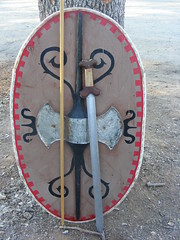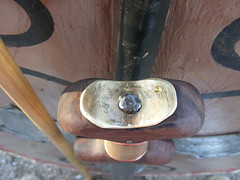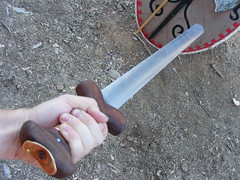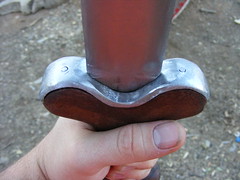| Author |
Message |
Joseph E.

Location: Northern California Joined: 16 Sep 2009
Posts: 15
|
 Posted: Thu 01 Oct, 2009 8:55 pm Post subject: My first sword making experience... Posted: Thu 01 Oct, 2009 8:55 pm Post subject: My first sword making experience... |
 |
|
99% complete with my stock removal La Tene III-inspired sword. Started out as a 1.5" x 1/4" mild steel flat bar. Cut out blank using a cut-off wheel on an angle grinder and a metal blade on my circular saw.
Guard plate is cold forged, as are the brass fittings. Wood guard, grip and pommel are riveted (relatively rare for my target period, but practical considering my inexperience) as well as tang-peened on. Guard and pommel are black walnut, white ash for the grip.
Went with a lenticular cross section with almost no distal taper because it is period-correct, and the more common tapering, diamond or hollow ground La Tenne II versions are more complex than I wanted to take on with a first attempt. I got impatient toward the end though, so I have some minor grinding to do to make it truly lenticular throughout, instead of very slightly hexagonal.
A little grinding, polishing, and then a period-inspired scabbard. Its pictured here with my homemade oval Celtic shield and a homemade javelin.
There are several flaws, including a slightly wavy surface due to heavy grinding, hammer marks, minor pitting in the steel blank, some asymmetry in the furniture, and a linear crack in the grip that occurred while peening the tang, but since I was going for a sword for a lower member of Celtic warrior nobility, I find some flaws acceptable, especially in an experimental virgin attempt. I also heavily distressed my shield, with lots of dents, hack marks and dried blood spatter, so some matching minor cosmetic battle damage to the sword may be forthcoming.





Thanks for looking!
Last edited by Joseph E. on Thu 01 Oct, 2009 11:11 pm; edited 1 time in total
|
|
  |
 |
|
Jake Wilson
|
 Posted: Thu 01 Oct, 2009 9:33 pm Post subject: LOOKS GREAT Posted: Thu 01 Oct, 2009 9:33 pm Post subject: LOOKS GREAT |
 |
|
The sword looks great. I assume it's a migration era sword? What are the pins in the grip? Is that typical of the period? I assume those are rivets. I am working on a viking sword myself. I hate power tools, so I'm actually in the process of cutting the fuller with sandpaper. Slow but it works. I am curious as to your tang/pommel pein. How did that go? Did you pein the tang cold or hot? How much height did you leave above the pommel to then pein into the pommel?
Any info would be appreciated. Was it tricky or relatively easy to do???
Anyway, nice sword.
Later.
|
|
  |
 |
|
C. Gadda
|
 Posted: Thu 01 Oct, 2009 10:25 pm Post subject: Posted: Thu 01 Oct, 2009 10:25 pm Post subject: |
 |
|
Very nice! And the mild steel is probably not all that far off from some of the originals (some were higher carbon or had high phospherous content for hardness, but some had very little carbon content)
I took the same cross section approach for the two La Tene style swords I've done thus far, though one is an ex-leaf spring and the other 5160 steel I got through a knife shop.
I like your shield, too. Very well executed.
|
|
 |
 |
Joseph E.

Location: Northern California Joined: 16 Sep 2009
Posts: 15
|
 Posted: Thu 01 Oct, 2009 11:10 pm Post subject: Re: LOOKS GREAT Posted: Thu 01 Oct, 2009 11:10 pm Post subject: Re: LOOKS GREAT |
 |
|
| Jake Wilson wrote: | The sword looks great. I assume it's a migration era sword? What are the pins in the grip? Is that typical of the period? I assume those are rivets. I am working on a viking sword myself. I hate power tools, so I'm actually in the process of cutting the fuller with sandpaper. Slow but it works. I am curious as to your tang/pommel pein. How did that go? Did you pein the tang cold or hot? How much height did you leave above the pommel to then pein into the pommel?
Any info would be appreciated. Was it tricky or relatively easy to do???
Anyway, nice sword.
Later. |
Jake,
Thanks for the compliments. No, it isn't a migration era sword, although I do think a Germanic sword would be a fun project. This one is a Celtic 'La Tene III' type sword, c.a. late 2nd century BC to Roman conquest of Gaul. The pins are steel rivets, which are found in very few Celtic swords of the period, actually. Most furniture, like Roman swords, was peened on with the tang. Mine is as well, using a fabricated brass washer. I did heat the tang end with a torch, which was tricky with a wooden pommel. Not only did I have to worry about burning the wood, but I actually bent the tang inside the pommel and broke 2 of them. Had to make 3 pommels before it worked. On your Viking sword, your pommel will be brass or iron, presumably, so you shouldn't have this problem.
On my next one I'll leave more steel clear of the pommel to work with. I should have used a much thicker tang washer, but it was too short. This was part of the reason for the rivets. The peen is tight, but I don't trust that thin brass, so I strengthened the whole thing with some pins. If I had been more patient, I would have re-cut the tang shoulders to lengthen the tang and allow for a stronger system. The peen I have here started out as a 5/16" dia x 3/8" long tip protruding past the washer, if that helps.
Overall, it was a moderately easy project. Made mistakes, but I learned I can make a sword...next one will be more refined.
Thanks for your interest and good luck on your project. You clearly have the patience to produce an excellent weapon. Hope to see some pics in the next year or two 
|
|
  |
 |
Joseph E.

Location: Northern California Joined: 16 Sep 2009
Posts: 15
|
 Posted: Thu 01 Oct, 2009 11:27 pm Post subject: Posted: Thu 01 Oct, 2009 11:27 pm Post subject: |
 |
|
| C. Gadda wrote: | Very nice! And the mild steel is probably not all that far off from some of the originals (some were higher carbon or had high phospherous content for hardness, but some had very little carbon content)
I took the same cross section approach for the two La Tene style swords I've done thus far, though one is an ex-leaf spring and the other 5160 steel I got through a knife shop.
I like your shield, too. Very well executed. |
Thanks! I'm pretty pleased with them. Both the shield and sword are my first attempts. I've definitely 'caught the bug.'
I was thinking the same thing about the mild steel. I have held off making a sword for years for lack of a good source for hardened steel, or the know-how to work it without turning it into mild steel:D After taking an interest in Celtic weaponry, I learned that sword steel temper varied (as low as the stuff that had to be 'bent against the foot' to straighten it.
Can you direct me to some shots of your work? I'd love to see what a fellow grinder (especially one with more experience than I have) can produce.
|
|
  |
 |
|
|
You cannot post new topics in this forum
You cannot reply to topics in this forum
You cannot edit your posts in this forum
You cannot delete your posts in this forum
You cannot vote in polls in this forum
You cannot attach files in this forum
You can download files in this forum
|
All contents © Copyright 2003-2025 myArmoury.com — All rights reserved
Discussion forums powered by phpBB © The phpBB Group
Switch to the Basic Low-bandwidth Version of the forum
|

